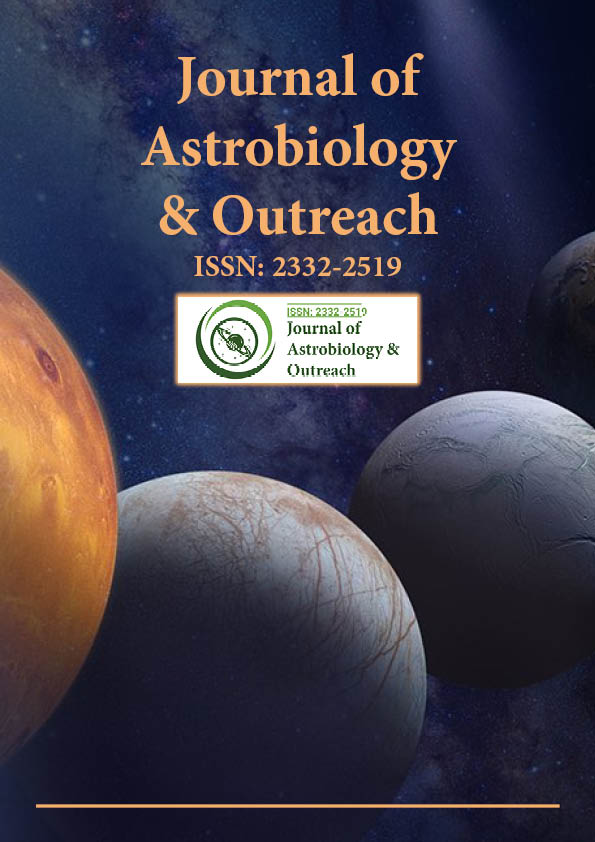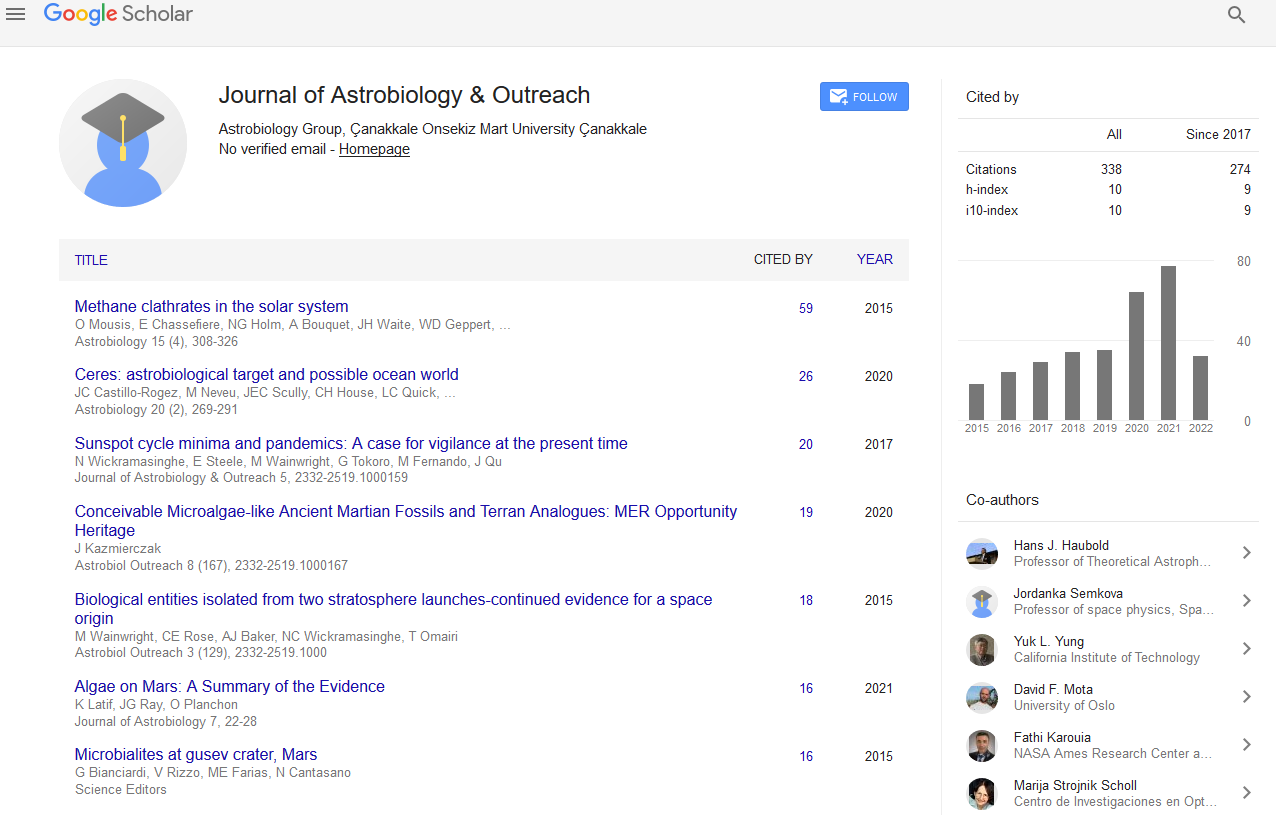Indexed In
- Open J Gate
- Academic Keys
- JournalTOCs
- RefSeek
- Hamdard University
- EBSCO A-Z
- OCLC- WorldCat
- Google Scholar
Useful Links
Share This Page
Journal Flyer

Open Access Journals
- Agri and Aquaculture
- Biochemistry
- Bioinformatics & Systems Biology
- Business & Management
- Chemistry
- Clinical Sciences
- Engineering
- Food & Nutrition
- General Science
- Genetics & Molecular Biology
- Immunology & Microbiology
- Medical Sciences
- Neuroscience & Psychology
- Nursing & Health Care
- Pharmaceutical Sciences
Opinion Article - (2023) Volume 11, Issue 5
Biosignatures in the Cosmos: Evidences to Alien Life in Exobiology
Andrea Rinaldi*Received: 22-Aug-2023, Manuscript No. JAO-23-24778; Editor assigned: 25-Aug-2023, Pre QC No. JAO-23-24778(PQ); Reviewed: 08-Sep-2023, QC No. JAO-23-24778; Revised: 15-Sep-2023, Manuscript No. JAO-23-24778(R); Published: 25-Sep-2023, DOI: 10.35248/2332-2519.23.11.312
Description
The search for extraterrestrial life has been a driving force in the field of exobiology, the branch of science dedicated to the study of life beyond Earth. While direct observation of alien organisms remains elusive, scientists are actively searching for biosignatures indirect indicators of life that could be present in the atmospheres or surfaces of distant celestial bodies.
Biosignatures are observable features or substances that can be used to infer the presence of life. On Earth, familiar biosignatures include the oxygen produced by photosynthetic organisms and the methane released by certain bacteria. In the context of exobiology, scientists are keen to identify analogous signatures on other planets or moons that may indicate the presence of extraterrestrial life.
One of the most potentail avenues for detecting biosignatures is through the analysis of atmospheric gases. On Earth, the presence of oxygen in the atmosphere is a strong indicator of photosynthetic life. Similarly, the detection of gases like methane or nitrous oxide on an exoplanet could suggest the activity of biological processes.
Unusual chemical imbalances in a planetary atmosphere can be suggestive of life. For instance, the coexistence of reactive gases like oxygen and methane is typically unstable over long periods unless actively replenished by living organisms. Identifying such chemical disequilibria can point towards ongoing biological activity.
The surface of a celestial body can also reveal potential biosignatures. Patterns such as vegetation-like color variations, seasonal changes, or unexpected surface compositions may indicate the presence of living organisms or their byproducts.
Pigments, molecules responsible for the coloration of living organisms, can leave distinctive spectral signatures. Identifying unusual pigments in the light reflected or emitted by a distant planet could suggest the presence of alien photosynthetic life.
The presence of complex organic molecules, such as proteins or nucleic acids, can be indicative of life. Analyzing the composition of a celestial body's surface or atmosphere for these biological macromolecules is a key aspect of the search for extraterrestrial life.
The simultaneous presence of oxygen and ozone in a planet's atmosphere, known as the oxygen-methane disequilibrium, is a strong biosignature candidate. Oxygen, produced by photosynthetic organisms, tends to react with methane, leading to a state of chemical imbalance that may indicate the presence of life.
While methane can be produced by geological processes, its presence in combination with other gases, such as oxygen or water vapor, can be indicative of biological activity. Methane is a potential biosignature, particularly when found in conjunction with other compounds associated with life.
Chlorophyll, the green pigment essential for photosynthesis on Earth, has specific absorption bands in the visible spectrum. Detecting similar absorption features in the light from a distant planet could suggest the presence of photosynthetic organisms.
Liquid water is a fundamental requirement for life as we know it. The detection of liquid water on the surface of an exoplanet or moon, especially in the habitable zone, increases the likelihood of the environment being conducive to life.
The search for biosignatures in the cosmos represents a critical step in our exploration of the potential for extraterrestrial life. As our telescopes become more sophisticated and our understanding of the conditions necessary for life expands, the identification of these indirect indicators becomes more achievable. While no definitive evidence has been found yet, the ongoing research in exobiology is pushing the boundaries of our cosmic knowledge and instilling a sense of wonder about the possibility of life beyond our home planet. The study of biosignatures not only enhances our understanding of the conditions necessary for life but also fuels the excitement and curiosity surrounding the potential discovery of alien life in the vastness of the cosmos.
Citation: Rinaldi A (2023) Biosignatures in the Cosmos: Evidences to Alien Life in Exobiology. J Astrobiol Outreach. 11:312.
Copyright: © 2023 Rinaldi A. This is an open-access article distributed under the terms of the Creative Commons Attribution License, which permits unrestricted use, distribution, and reproduction in any medium, provided the original author and source are credited.

